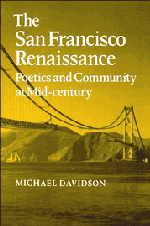7 - Approaching the Fin de Siècle
Published online by Cambridge University Press: 01 June 2011
Summary
THE SECOND GENERATION
Part of the enchantment of Helen Adam's ballad opera, San Francisco's Burning, comes from its playful re-creation of a turn-of-the-century city, part western history, and part fantasy. Like the gaily filigreed Victorian houses for which San Francisco is famous, the literature we have been considering was built upon simple structures with considerable embellishment. “This land, where I stand,” Robert Duncan announces, “was all legend / in my grandfather's time,” and the task for many poets of Duncan's generation was to revive that legend so that “all the old stories / whisper once more.” The rhetoric in which that legend was retold at mid-century was often, though not exclusively, that of the 1890s. The opulent diction of Pre-Raphaelite, Yellow Book poets from Swinburne to Dowson and Yeats can be felt in many of the poets we have considered in this book. As I pointed out in my chapter on Duncan, that rhetoric found little favor with Charles Olson and other East Coast peers who picked up a note of decadence in the Duncan circle and used it as a challenge. Whatever one may think of Olson's deprecations, the tone was there, and it became one of the characteristic features of the era's period style.
As we move ever closer to our own fin de siècle – and to the millenium that it signals – it is worth exploring how the ideals of a poetic renaissance have changed in the two decades since Jack Spicer's death.
- Type
- Chapter
- Information
- The San Francisco RenaissancePoetics and Community at Mid-Century, pp. 200 - 218Publisher: Cambridge University PressPrint publication year: 1989



